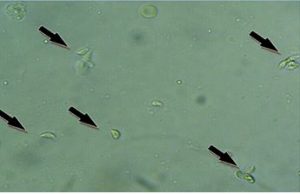Planning pregnant or being pregnant? You better be wary of this one parasite. This parasite was named Toxoplasma gondii and caused a disease called toxoplasmosis. This disease can affect anyone, both men and women – including pregnant women or not.
This parasite uses a cat as a devinitive hostpes herbivores, carnivores, omnivara including mammals and birds that may also be infected. Geographically, infection generally occurs in warm climates and Indonesia is one of them.
The prevalence of T. gondii in humans in Indonesia ranges from 2-63%. In 1964, de roever-bonnet et al. Found 24% of the indigenous population aged 10-50 years in Irian Jaya. Sayoga reported, of 288 pregnant women examined, the incidence of pregnant women in the blood positive for Toxoplasma infected was 14.25%.
Toxoplasma gondii is an intracellular protozoan parasite. The parasitic form of Toxoplasma gondii is like a curved rod with a smaller size of red blood cells (3-6 μm), can penetrate cells actively and enter various tissues such as drugs, brain, eyes, and intestines.
This parasite has 3 forms in the life cycle – takizoit, cyst (bradizoit) and ookista. Ookista size 10-12 um, has a definitive hospes cat.

How the symptoms?
First, inadvertently swallow the cat’s faeces in which there are Toxoplasma eggs. This method is much unconscious, such as touching the mouth with hands that have been contaminated as after gardening, cleaning the place to eat cat or other items that have been contaminated.
Secondly, this parasite can also infection if consuming meat that has been contaminated and not cooked well. The cyst form of this parasite can enter with the meat.
Third, enter through contaminated water. And rarely, if you receive organ transplants or blood transfusions from contaminated donors.
If in good health, generally this disease does not cause any symptoms. Various studies reveal, women who reproduce toxoplasmosis infected can face the risk of impaired immunity that can affect fertility. This happens because this parasite attacks every nucleated cell, including gamete cells that will lead to the failure of fertilization or the destruction of the zygote (the fetus). Infected fetus of toxoplasma can be miscarriage, fetal dead, fetal growth inhibited, premature infant, hydrocephalus, micro-ophthalmia (small eye size), choriorenitis (inflammation of the retina of the eye), blindness, deafness, brain lesions, and organ damage. Severe of symptoms depends on when pregnant women are infected. If it occurs in the first trimester, the likelihood is 15-20%, in the second trimester it is 25-30%, whereas in the third trimester it is likely that 60% of infants will be infected with their mother.
However, 90% of infected infants produce no symptoms (asymptomatic) at the time the baby is born. New symptoms arise months or even years after the baby is born. Toxoplasmosis is the TORCH syndrome (toxoplasma, rubella, cytamegalovirus / CMV and herpes simplex) the toughest.
Diagnosis and Treatment
Diagnosis of toxoplasmosis in adults is very difficult because the disease is usually not accompanied by significant symptoms. New suspicions arise after the child is born with the disorder and it is too late. Examinations that can be performed include serological examination (blood serum).Laboratory test is often carried out along with rubella, cytomegalovirus, and herpes simplex, so it is often referred to as TORCH examination. A person is otherwise infected with toxoplasmosis if in his blood is detected (immunoglobulin M) IgM antibody and IgG positive antibody.
This test is useful because if the result is suspicious, the health professional can carry out further investigations that support such as ultrasound, amniocentesis (sampling of amniotic fluid) so that the action and medication given can be appropriate. Surely this will prevent worse things from happening. Another commonly used method of diagnosis is indirect haemglutination (IHA), immuniflourescence (IFAT) or enzyme immunoassay (elisa). Preliminary screening is highly recommended, especially in high risk pregnant women. Toxoplasmosis in pregnant women with good body resistance, usually does not require special handling. Treatment aimed at reducing the risk to the fetus.
Prevention of Toxoplasmosis in Pregnancy
1. Avoid consuming raw or undercooked meat, as well as unwashed fruits and vegetables.
2. As much as possible control the insects that can spread cat litter such as flies and cockroaches.
3. If you have a pet cat, do not let to roam outside the home that increases the likelihood of contact with toxoplasma.
4. Have other family members help clean your cat including bathing, washing cages and food places5. Feed your cat with well-cooked foods.
6. Perform regular checks on the health of your cat.
7. Use plastic gloves when you have to clean cat litter.
8. Wash hands before eating and after contact with raw meat, soil or cat.
